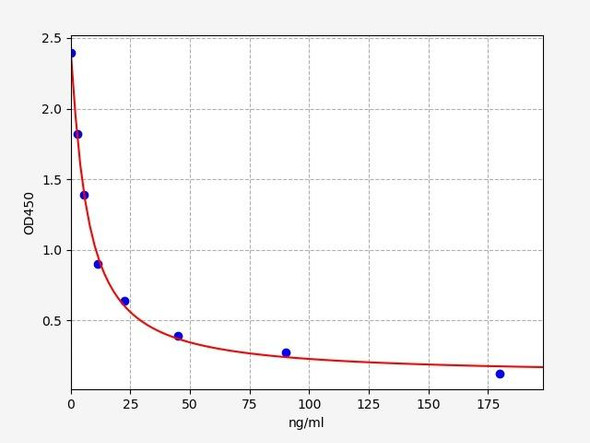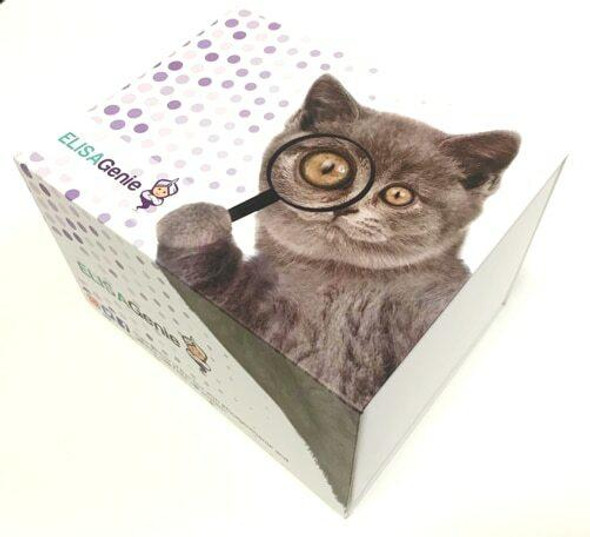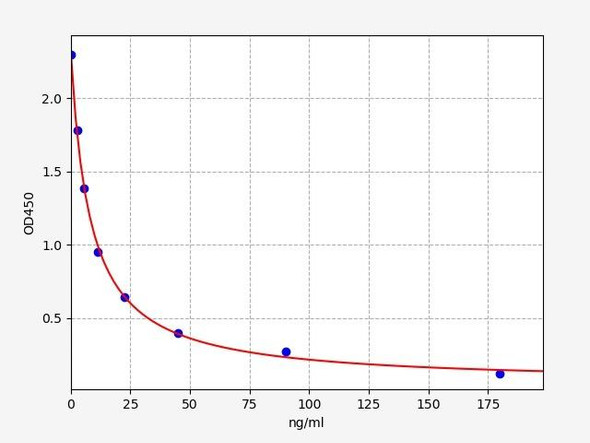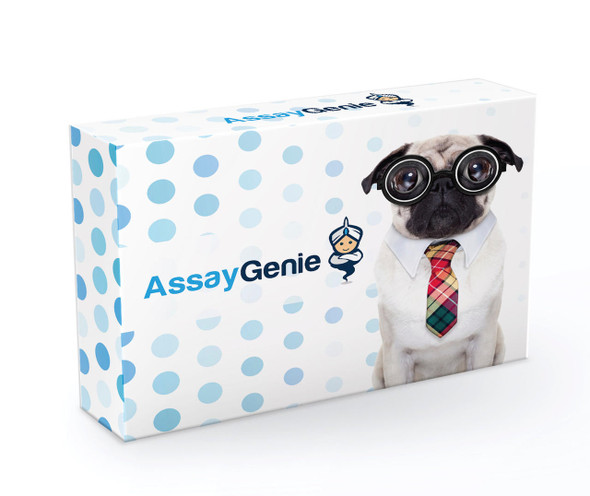Rat Signaling ELISA Kits 5
Rat/Chicken CORT (Corticosterone) ELISA Kit
- SKU:
- RTES01207
- Product Type:
- ELISA Kit
- Size:
- 96 Assays
- Sensitivity:
- 0.24ng/mL
- Range:
- 0.39-25ng/mL
- ELISA Type:
- Competitive
- Reactivity:
- Rat
- Reactivity:
- Chicken
- Sample Type:
- Serum, plasma, urine
Description
Rat/Chicken CORT (Corticosterone) ELISA Kit
This ELISA kit uses the Competitive-ELISA principle. The micro ELISA plate provided in this kit has been pre-coated with CORT. During the reaction, CORT in the sample or standard competes with a fixed amount of CORT on the solid phase supporter for sites on the Biotinylated Detection Ab specific to CORT. Excess conjugate and unbound sample or standard are washed away, and Avidin-Horseradish Peroxidase (HRP) conjugate are added to each micro plate well and incubated. Then a TMB substrate solution is added to each well. The enzyme-substrate reaction is terminated by the addition of stop solution and the color turns from blue to yellow. The optical density (OD) is measured spectrophotometrically at a wavelength of 450 nm ± 2 nm. The concentration of CORT in tested samples can be calculated by comparing the OD of the samples to the standard curve.
| Assay type | Competitive-ELISA |
| Format | 96T/48T |
| Assay time | 2.0h |
| Reactivity | Rat/Chicken |
| Detection Method | Colormetric |
| Detection Range | 0.39-25 ng/mL |
| Sensitivity | 0.24 ng/mL |
| Sample Volume Required Per Well | 50µl |
| Sample Type | Serum, plasma, urine |
Specificity
This kit recognizes CORT in samples. No significant cross-reactivity or interference between CORT and analogues was observed.
Typical Data
As the OD values of the standard curve may vary according to the conditions of the actual assay performance (e.g. operator, pipetting technique, washing technique or temperature effects), the operator should establish a standard curve for each test. Typical standard curve and data is provided below for reference only.
| Concentration (ng/mL) | O.D |
|---|---|
| 25 | 0.206 |
| 12.5 | 0.410 |
| 6.25 | 0.623 |
| 3.12 | 0.957 |
| 1.56 | 1.249 |
| 0.78 | 1.509 |
| 0.39 | 1.832 |
| 0 | 2.352 |
Precision
Intra-assay Precision (Precision within an assay): 3 rat samples with low, mid range and high level CORT were tested 20 times on one plate, respectively.
Inter-assay Precision (Precision between assays): 3 rat samples with low, mid range and high level CORT were tested on 3 different plates, 20 replicates in each plate.
| Intra-assay Precision | Inter-assay Precision | |||||
|---|---|---|---|---|---|---|
| Sample | 1 | 2 | 3 | 1 | 2 | 3 |
| n | 20 | 20 | 20 | 20 | 20 | 20 |
| Mean (ng/mL) | 30.38 | 101.43 | 206.56 | 31.45 | 102.78 | 208.75 |
| Standard deviation | 2.66 | 7.77 | 14.56 | 2.91 | 8.82 | 18.02 |
| C V (%) | 8.77 | 7.66 | 7.05 | 9.24 | 8.58 | 8.63 |
Recovery
The recovery of CORT spiked at three different levels in rat samples throughout the range of the assay was evaluated in various matrices.
| Sample Type | Range (%) | Average Recovery (%) |
|---|---|---|
| Serum (n=5) | 81-90 | 85 |
| EDTA plasma (n=5) | 86-97 | 89 |
| Urine (n=5) | 85-102 | 96 |
Linearity
Rat samples were spiked with high concentrations of CORT and diluted with Reference Standard & Sample Diluent to produce samples with values within the range of the assay.
| Serum (n=5) | EDTA plasma (n=5) | Urine (n=5) | ||
|---|---|---|---|---|
| 1:2 | Range (%) | 80-90 | 88-101 | 85-106 |
| Average (%) | 85 | 96 | 94 | |
| 1:4 | Range (%) | 82-94 | 87-94 | 80-101 |
| Average (%) | 88 | 91 | 92 | |
| 1:8 | Range (%) | 84-100 | 82-89 | 83-96 |
| Average (%) | 93 | 86 | 88 | |
| 1:16 | Range (%) | 87-105 | 89-104 | 84-99 |
| Average (%) | 91 | 99 | 89 |
Kit Components & Storage
An unopened kit can be stored at 2-8°C for 1 month. If the kit is not supposed to be used within 1 month, store the components separately according to the following conditions once the kit is received.
| Item | Specifications | Storage |
|---|---|---|
| Micro ELISA Plate(Dismountable) | 96T: 8 wells ×12 strips 48T: 8 wells ×6 strips | -20'C, 6 months |
| Reference Standard | 96T: 2 vials 48T: 1 vial | |
| Concentrated Biotinylated Detection Ab (100X) | 96T: 1 vial, 120 μL 48T: 1 vial, 60 μL | |
| Concentrated HRP Conjugate (100X) | 96T: 1 vial, 120 μL 48T: 1 vial, 60 μL | -20'C(Protect from light), 6 months |
| Reference Standard & Sample Diluent | 1 vial, 20 mL | 2-8'C, 6 months |
| Biotinylated Detection Ab Diluent | 1 vial, 14 mL | |
| HRP Conjugate Diluent | 1 vial, 14 mL | |
| Concentrated Wash Buffer (25X) | 1 vial, 30 mL | |
| Substrate Reagent | 1 vial, 10 mL | 2-8'C(Protect from light) |
| Stop Solution | 1 vial, 10 mL | 2-8'C |
| Plate Sealer | 5 pieces | |
| Product Description | 1 copy | |
| Certificate of Analysis | 1 copy |
Rat/Chicken CORT(Corticosterone) ELISA Kit (RTES01207) Assay Procedure
- 1. Add the Standard working solution to the first two columns: Each concentration of the solution is added in duplicate, to one well each, side by side(50µl for each well). Add the samples to the other wells(50µl for each well). Immediately add 50µl of Biotinylated Detection Ab working solution to each well. Cover the plate with the sealer provided in the kit. Incubate for 45 min at 37°C. (Note: solutions should be added to the bottom of the micro ELISA plate well, avoid touching the inside wall and causing foaming as much as possible)
- 2. Aspirate or decant the solution from each well,add 350µl of wash buffer to each well. Soak for 1~2 min and aspirate or decant the solution from each well and pat it dry against clean absorbent paper. Repeat this wash step 3 times. Note: a microplate washer can be used in this step and other wash steps.
- 3. Add 100µl of HRP Conjugate working solution to each well. Cover with the Plate sealer. Incubate for 30 min at 37°C.
- 4. Aspirate or decant the solution from each well, repeat the wash process for five times as conducted in step 2.
- 5. Add 90µl of Substrate Reagent to each well. Cover with a new plate sealer. Incubate for about 15 min at 37°C. Protect the plate from light. (Note: the reaction time can be shortened or extended according to the actual color change, but not more than 30min)
- 6. Add 50µl of Stop Solution to each well. (Note: Adding the stop solution should be done in the same order as the substrate solution)
- 7. Determine the optical density (OD value) of each well at once with a micro-plate reader set to 450 nm.






